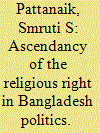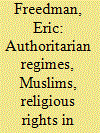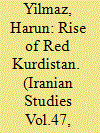| Srl | Item |
| 1 |
ID:
086244


|
|
|
|
|
| Publication |
2009.
|
| Summary/Abstract |
The ascendancy of Jamaat Islami to power in a country that was born on the basis of secularism indicates the changing political dynamics in Bangladesh. Its syncretic tradition rooted in its language and culture limited Jamaat's success. Nevertheless, given the role the party played during the liberation war, its political ascendancy speaks of the changing political landscape. This article argues that though the party has exhibited some political success, it faces challenges from the secularists in the socio-cultural sphere, thereby limiting its growth and expansion.
|
|
|
|
|
|
|
|
|
|
|
|
|
|
|
|
| 2 |
ID:
096067


|
|
|
| 3 |
ID:
116406


|
|
|
|
|
| Publication |
2012.
|
| Summary/Abstract |
This paper elucidates patterns of cooperation over the past three decades between some Islamic and secular organizations in Turkey's human rights movement. This paper argues the human rights master frame provided the building blocks for activists to build bridges among ideologically disparate organizations. As a result, a process of reconciliation blossomed in the mid-1990s during a tumultuous period of unprecedented opportunities and severe repression. In addition to the human rights master frame, which formed an ideational bridge across distinct agendas, organizational leaders served as brokers, battling a culture of mistrust and intolerance through confidence-building measures. Although movement activists have made great strides in reconciling differences, two issues-lesbian, gay, bisexual, transsexual rights and external funding-pose new challenges to cross-cleavage partnerships.
|
|
|
|
|
|
|
|
|
|
|
|
|
|
|
|
| 4 |
ID:
133822


|
|
|
|
|
| Publication |
2014.
|
| Summary/Abstract |
Current literature on twentieth century Kurdish history overwhelmingly covers Kurdish populations and national movements within the borders of Turkey, Iran, Iraq and Syria. This article, hoin Armenia, Georgia, and Azerbaijan,ever, focuses on Soviet Kurdistan and Kurdish policy in Azerbaijan between 1920 and 1937 through the broader question of national minorities within the republic. It is claimed here that the Soviet policy on Azerbaijani Kurds was part of a multilayered issue. First of vnall, the Kurds of Azerbaijan were semi-nomadic mountain dwellers transformed by the modernization policies implemented in Soviet territories. Azerbaijani Kurds were a national identity within the Soviet Union and thus subject to ethnophilic All-Union policies in those years. Finally, Kurds were one of the numerous national minorities in the Soviet Socialist Republic of Azerbaijan who were exposed to the national minority policies executed within the republic by the administration in Baku. The national minority policy in Azerbaijan was often contested and limited by local conditions and obstacles. Therefore, the granting of cultural rights in the 1920s to national minorities, which included the Kurds of Azerbaijan, the promotion of these rights in the 1920s and 1930s, and opposition to these policies can only be examined with regard to these three layers.
|
|
|
|
|
|
|
|
|
|
|
|
|
|
|
|